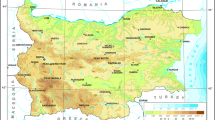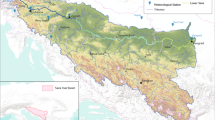Abstract
The research period is 1950–2012, and includes data for air temperatures in 21 Bulgarian stations. Two circulation indices, covering the same period and showing west–east or south–north directions of transport of air masses, were calculated. Statistical methods were used in the study. The results show a significant positive trend in average annual air temperatures in almost the entire territory of Bulgaria with the exception of its eastern-northeastern part. The warming occurs mainly in March, June and July, with some stations having significant positive values also in January, May and August. The zonal index reveals an insignificant increase of western transport of air masses in the cold half of the year (October–April) and strengthening of the eastern transport in the rest of the year. The meridional index shows an increase of the northern transport of air masses over the entire year and this is particularly visible in March, June, August and September. Correlation coefficients indicate that atmospheric circulation has leading role in determination of air temperatures during the period from November to April. Western transport of air masses leads to higher temperatures in spring, autumn and winter and to lower temperatures in summer. The influence of ENSO on atmospheric circulation over Bulgaria is weak, with a time lag of 2 months. El Niño is associated with increased western and northern transport of air masses, while La Niña is associated with increased eastern and southern transport of air masses over southeastern Europe.










Similar content being viewed by others
References
Alexandrov V, Schneider M, Koleva E, Moisselin JM (2004) Climate variability and change in Bulgaria during the 20th century. Theoret Appl Climatol 79(3–4):133–149
Annual Meteorological book (1950–1981) National Institute of Meteorology and Hydrology, Bulgarian Academy of Sciences, Sofia. (In Bulgarian)
Climate change 2007 (2007) IPCC Fourth Assessment Report http://www.ipcc.ch/
Nojarov P (2008) Air temperature variations at Cherni vruh peak for the period 1936–2007. Probl Geogr 3–4:154–166
Nojarov P (2009) Air temperature changes at Botev peak for the period 1941–2007. Probl Geogr 1:36–48
Nojarov P (2012a) Changes in air temperatures and atmosphere circulation in high mountainous parts of Bulgaria for the period 1941–2008. J Mt Sci 9:185–200. doi:10.1007/s11629-012-2224-x
Nojarov P (2012b) Bulgarian mountains air temperatures and precipitation—statistical downscaling of global climate models and some projections. Theor Appl Climatol 110(4):631–644. doi:10.1007/s00704-012-0709-8
Nojarov P (2013) Circulation over Bulgaria and its connection with NAO indices and sea surface temperatures. Theor Appl Climatol. doi:10.1007/s00704-013-0846-8
Nojarov P, Kalapov I (2010) Air temperature regime changes at peak Moussala for the period 1933–2008. Bulgarian J Meteorol Hydrol 15(1):21–31
Petkova N, Koleva E, Alexandrov V (2008) Winter climate variability at Danube Plane, North Bulgaria. In: XXIVth Conference of the Danubian countries on the hydrological forecasting and hydrological bases of water management. Bled, Slovenia. 2–4 June 2008. Conference e-papers. ISBN 978-961-91090-2-1
The NCEP/NCAR 40-year reanalysis project (1996) Bull Amer Meteor Soc, 77, 437–470
Tomingas O (2002) Relationship between atmospheric circulation indices and climate variability in Estonia. Boreal Environ Res 7:463–469
Topliisky D (2005) Chronological fluctuations of climate in Bulgaria during the 20th century. Dissertation, Sofia University, Sofia. (In Bulgarian)
Vankova N (1995) Chronological fluctuation of air temperature in the non-mountainous part of Bulgaria. Annuaire de l’Universite de Sofia “St. Kliment Ohridski”, Faculty of Geology and Geography 87 2—Geography: 341–366. (In Bulgarian)
Velev S (2006) Global climatic change and Bulgarian climate. Geography 21(2):4–8. (In Bulgarian)
Wilks DS (2006) Statistical Methods in the Atmospheric Sciences, Volume 91, Second Edition (International Geophysics), Elsevier
Wolter K, Timlin MS (1993) Monitoring ENSO in COADS with a seasonally adjusted principal component index. Proceedings of the 17th Climate Diagnostics Workshop, Norman, OK, NOAA/NMC/CAC, NSSL, Oklahoma Clim. Survey, CIMMS and the School of Meteor., Univ. of Oklahoma, 52–57
Wolter K, Timlin MS (1998) Measuring the strength of ENSO events—how does 1997/98 rank? Weather 53:315–324
Author information
Authors and Affiliations
Corresponding author
Additional information
Responsible editor: L. Gimeno.
Rights and permissions
About this article
Cite this article
Nojarov, P. Atmospheric circulation as a factor for air temperatures in Bulgaria. Meteorol Atmos Phys 125, 145–158 (2014). https://doi.org/10.1007/s00703-014-0332-6
Received:
Accepted:
Published:
Issue Date:
DOI: https://doi.org/10.1007/s00703-014-0332-6




